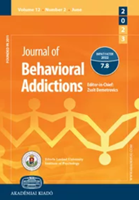Investigating gaming structural features associated with gaming disorder and proposing a revised taxonomical model: A scoping review
Investigating gaming structural features associated with gaming disorder and proposing a revised taxonomical model: A scoping review
Author(s): Nirav Saini, David C. HodginsSubject(s): Individual Psychology, Behaviorism, Substance abuse and addiction, Health and medicine and law
Published by: Akadémiai Kiadó
Keywords: gaming disorder; structural features; problematic gaming behavior; scoping review; video game addiction; taxonomy;
Summary/Abstract: Background and aims: Gaming disorder (GD) is a mental health concern that has been heavily contested by experts. This scoping review synthesizes the literature to identify the structural features of video game design that can contribute to GD. Furthermore, a taxonomy of the structural features implicated with GD is proposed, revised from earlier work. Methods: Seven databases, in addition to Google Scholar, were searched. Peer-reviewed studies were included if they assessed a link between gaming structural characteristics and GD or a proxy. The final pool included 105 articles. Results: Avatar creation and customizability, multiplayer characteristics, and reward and punishment features were highly represented in the literature. There was no evidence for three categories in the original taxonomy: support network features, sexual content, and explicit language. Furthermore, structural feature sub-categories emerged that were absent from the previous taxonomy, such as general socialization features, type of virtual world, and in-game currency. Manipulation and control features and presentation features were less represented than social features, narrative and identity features, and reward and punishment features. The reviewers propose two broad classes of addictive gaming structural features: ‘features enhancing in-game immersion and realism’ and ‘gambling-like features’. Discussion and conclusions: Numerous studies found a relationship between social, narrative and identity, and reward and punishment structural characteristics with GD. Two broad classes of gaming structural features were associated with addiction. The first, ‘features enhancing in-game immersion and realism,’ including social gameplay, avatar creation, storytelling, and graphics/sound. The second, ‘gambling-like features,’ included different mechanisms of rewards-and-punishment.
Journal: Journal of Behavioral Addictions
- Issue Year: 12/2023
- Issue No: 2
- Page Range: 352-374
- Page Count: 23
- Language: English

